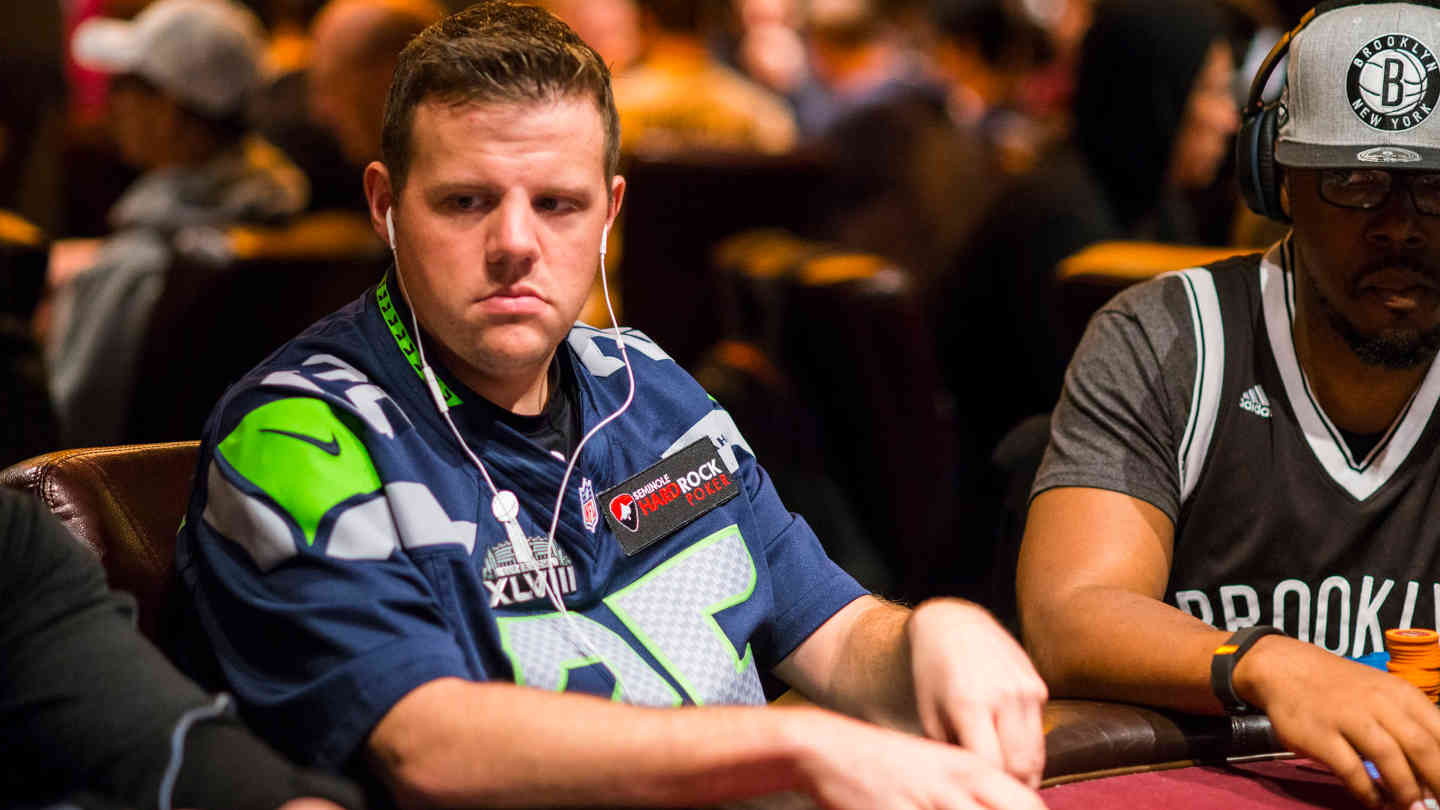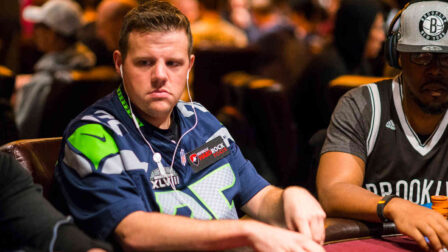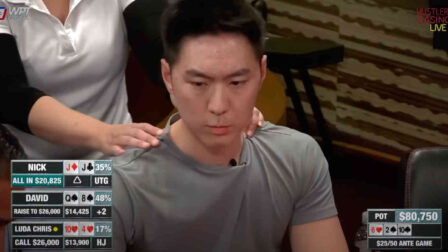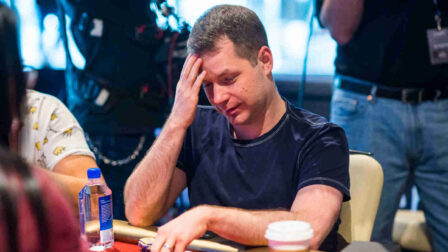Inside Straight Draw: How to Play Gutshot in the Most Profitable Way

10 minutes
Last Updated: March 19, 2024
Every time you get involved in a hand, you’re more likely to flop some kind of a draw than a made hand, so knowing how to play it correctly is vital.
In Texas Hold’em, some of these draws are very powerful; some, not as much. The one I’m going to talk about today, namely the inside straight draw, definitely belongs to the latter category.
The inside straight draw, or gutshot straight draw as it is often referred to, is one of the toughest draws to play.
Of course, it gives your hand some potential, so you don’t want to give up too soon. That being said, a lot of the time the math is not on your side and you are not always drawing to the nuts, so that is important to consider.
In this article, I will cover some of the most common spots you’re likely to encounter with a gutshot straight draw at the tables and share my insights on how to play it.
What Is Inside Straight (Draw)?
First thing first, let’s start with a definition for those new to the game.
The gutshot straight draw is the kind of draw where there are only four potential cards that can improve your hand into an actual straight.
It is much different from an open-ended draw where you usually have eight outs and are two times more likely to hit it.
An example of an inside straight draw would be you holding 78 and the board coming 5 9 K. The only way you can make your straight is if one of four sixes peels on the turn or the river.
Of course, not all four are necessarily “clean” outs as one of those could be completing someone’s flush, but I will talk more about it later.
Inside Straight Draw Odds
Every time you think about strategies for a certain poker scenario, you first need to know the basic math behind it and understand poker odds.
So, what are the actual inside straight draw odds, and how likely are you to make your hand on the turn or the river?
There is no need to make things too complex here, and I will stick to the straightforward “Rule of Two and Four.” You take the number of outs you have and multiply it by two to get your odds for the turn or by four to get the odds for the river.
For the inside straight draw, you’ll always have four outs, so:
- Chances of making your straight on the turn: 4 * 2 = 8%
- Chances of making your straight by the river: 4 * 4 = 16%
While these numbers aren’t 100% precise and will depend on other backdoor options, they’re a very good approximation.
Whether you’re 8% or 9% to make your straight with one card to come doesn’t make that much difference in your actual strategy. You just need to know where you stand.
Knowing what is inside straight and what the inside straight draw odds are is essential for any further discussion. People often get way too involved with these hands despite the fact the numbers simply don’t add up.
Gutshot straight draw is, in fact, one of the weakest draws in poker, and you need to treat it as such.
Nutted vs. Non-nutted Gutshot Straight Draws
Now that I’ve explained some basic numbers, it should be pretty clear why chasing your inside straight draws is often not a very good idea. However, the situation can become even worse if the gutshot you’re trying to make is not the nuts.
For example, let’s say you’re holding 56, and the board comes 4 8 9.
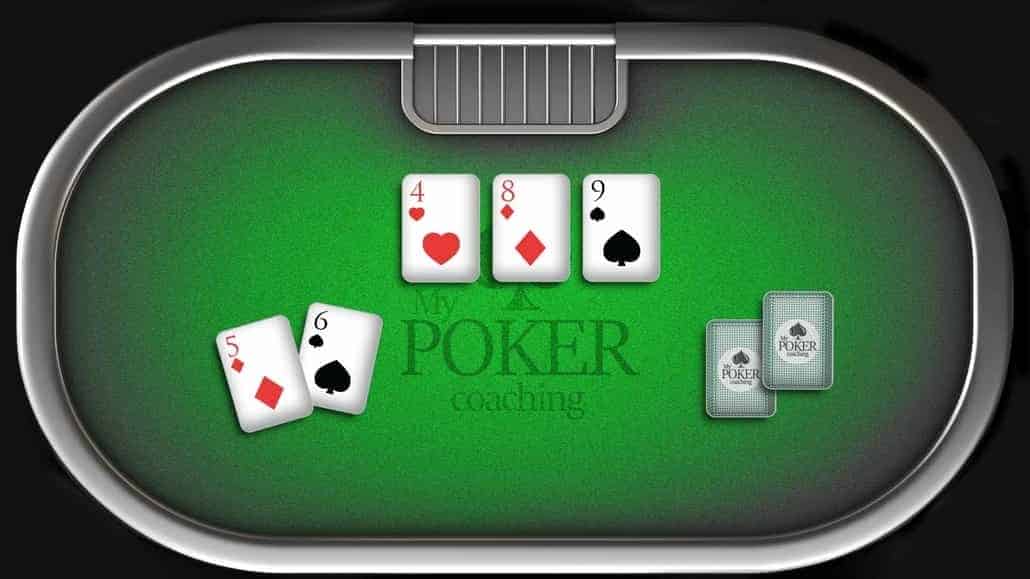
You need any 7 to complete your draw, and you already know the odds of that happening aren’t exactly favorable.
To make things even worse, when you do get lucky and get one of those cards you need, you’ll only have the third nuts. Anyone with T6 or JT will have made a better straight.
Now, poker isn’t an exact science, and the unknown element is what makes the game fun to play. I’m not saying that you should never play in these scenarios. What I am saying, though, is that you need to be very careful chasing inside straight draws that don’t make the nuts.
One of the main motivations for chasing a gutshot straight is the implied odds, i.e., the amount of money you can get from your opponents when you do make your hand.
However, the scenario where you are not very likely to hit your draw, combined with a fact that when you do hit your “magic” card, it can easily make you the second-best hand is a recipe for disaster.
So treat nut gutshot straight draws, and non-nut draws differently, and be more willing to fold the latter one most of the time. The risk of making your hand and then being in a situation where you are drawing dead is not worth it.
Inside Straight Draws & Dirty Outs
Similar to the previous example, you need to be careful in the spots where one of your four outs is actually “dirty,” meaning it could easily make a better hand for one of your opponents.
It is primarily the case on two-tone boards where one of your cards could complete someone’s flush draw.
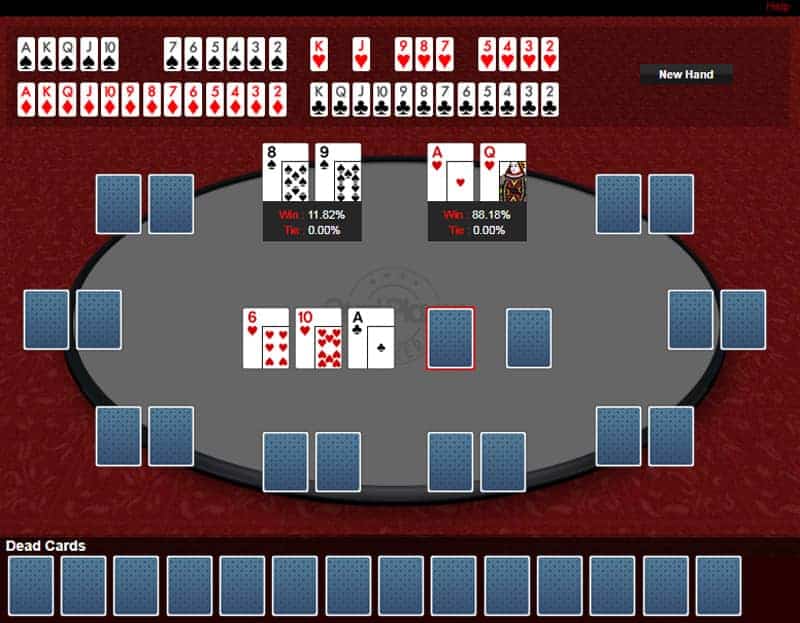
It is a similar scenario to the one I described earlier with a subtle difference that three of your outs will give you the nuts. The fourth one, however, i.e., the 7h, is a problem card that you both want and don’t want to see on the turn or the river.
Of course, not every time that 7h hits someone will make a flush. You can still go for value when you make your hand even when the flush card appears, but it reduces the profitability of your gutshot straight draws in the long run, so keep it in mind.
You can always use poker software to distinguish your opponents and see when you should be betting in these spots.
Playing Inside Straight Draws Profitably
By this point, I believe I’ve covered some of the most important points about gutshot straight draws and things you need to consider.
So, the question becomes what the most profitable way to play inside straight draws is?
Like with most things in poker, there isn’t one answer that fits all possible scenarios and situations. Thus, I will try to go through some of the most common spots and offer some food for your thought that should help you avoid many pitfalls on the way.
Playing as a Preflop Aggressor
When you’re the one with the initiative and flop an inside straight draw, you’ll have to decide whether to continue with aggression or check to see what happens on the turn. As always, being in a position helps a lot.
As a rule of thumb, you should be betting your gutshot draws in position when you are preflop aggressor to take advantage of fold equity.
Contrary to this, when you are OOP, you should be more inclined to check because you are in a much worse situation with less chance to make your opponent fold.
That being said, you should be looking to check back some of the time with your weakest inside draws, and for that, you need to be able to distinguish bad draws from the good ones and act accordingly.
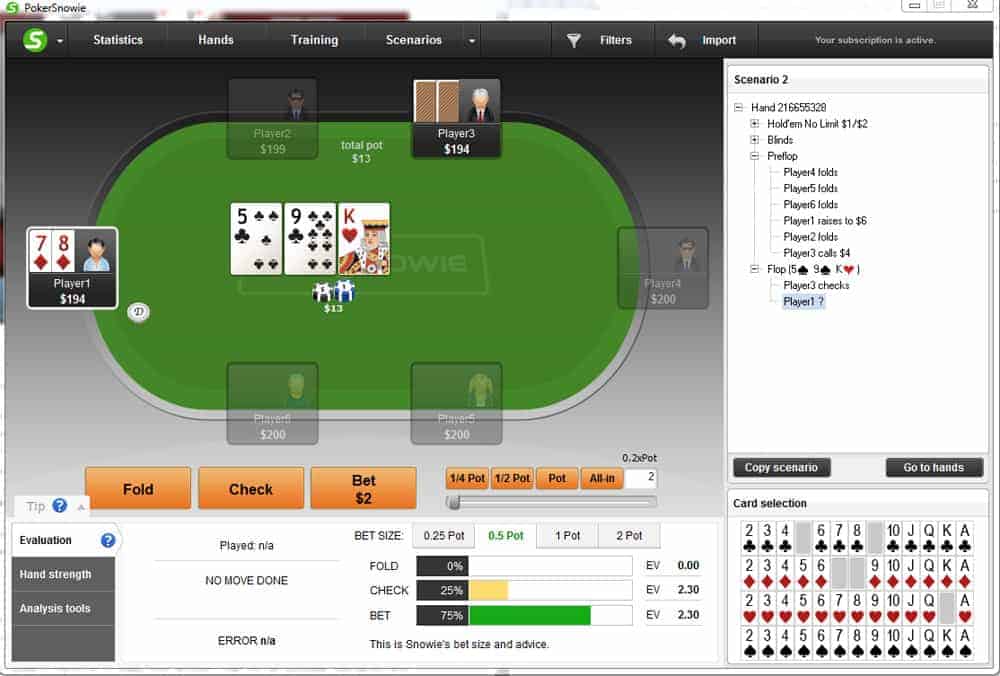
Get PokerSnowie FREE Trial and try it yourself!
In this situation, Poker Snowie suggests checking behind some of the time. This helps to balance your play on more coordinated board textures and prevents you from bloating the pot when you do not even have all clean outs.
Depending on what peels on the turn, you may fire out a delayed continuation bet if the opponent checks again.
In this case, your gutshot draw serves more as a backup while you’re relying on the aggression to win the pot and might consider barreling the river as well, depending on what card peels.
However, if the board structure changes slightly to be more favorable for your hand, you’ll probably want to continuation bet. If there is no flush draw on the board, for example, or you have a backdoor flush draw yourself, you’ll pretty much always want to continue with the aggression.
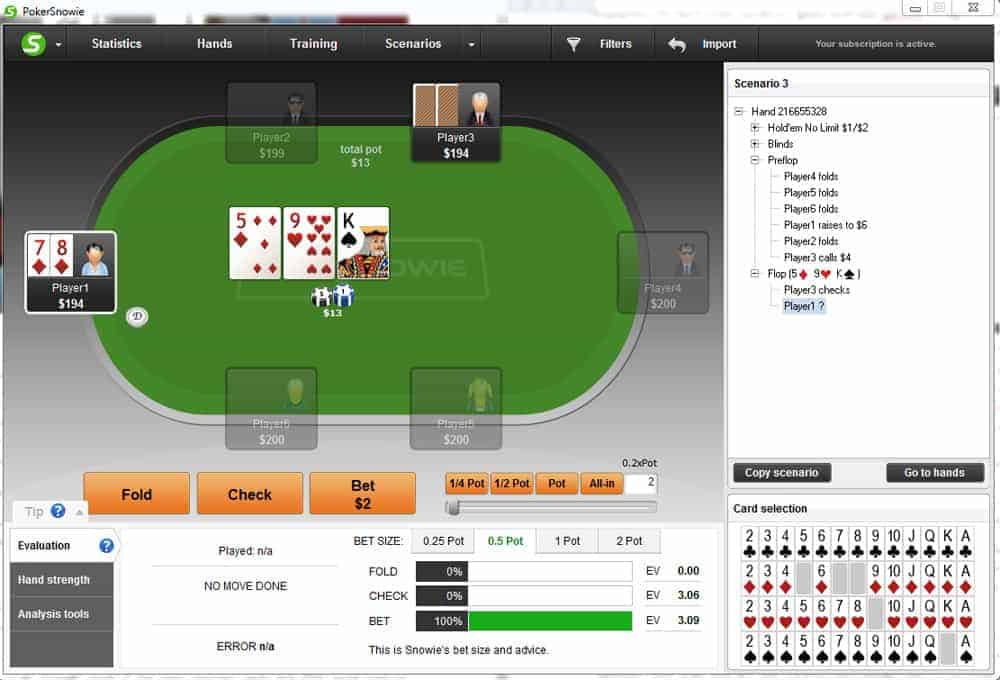
The EV of c-betting is slightly higher than the EV of checking back, and Snowie suggests you should barrel this flop 100%.
Even without hitting your hand, you have plenty of opportunities to continue your aggression and take down the pot. Any diamond peeling on the turn will give you more than enough equity to keep betting, putting maximum pressure on your opponent.
Combined with a few bluff cards that you might want to use as well (such as Aces and maybe Queens), you should be able to win the pot very frequently as your opponent will struggle to continue with anything but the top pair.
Playing Without Initiative
It is probably fair to say that playing a gutshot draw with the initiative is much easier as you have more options available to you.
Things get tricky when you have a shot at an inside straight but you’re the one defending and your opponent is driving the action.
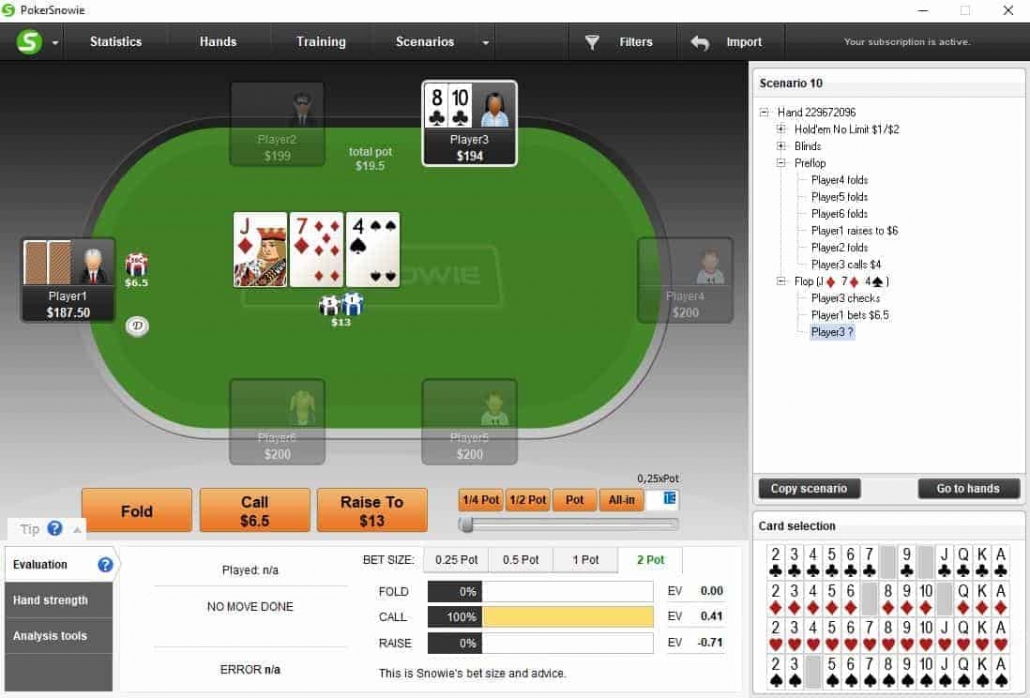
Get PokerSnowie FREE Trial and try it yourself!
The default action with a gutshot straight draw is to call a bet on the flop and go from there.
However, in case you are not drawing to the nuts or have a flush draw on the flop making one of the outs questionable, folding is your best option.
With the standard check-call line, you can follow another rule of the thumb on the turn:
- If you don’t pick any additional equity and your opponent bets, just fold.
If the turn peels something like Kh or As, or even a blank as 2x or 3x, you won’t be getting correct odds to continue chasing your inside straight to the river against any reasonable bet and should fold.
However, if you do pick additional outs, like a 6x for the double-guthost or a club for a flush draw, you can check-call once again if your opponent doesn’t overbet the pot.
Most poker training sites will tell you that any bet between up to 60% of the pot is an easy call on the turn.
Gutshot Straight Draws in Multiway Pots
As the number of opponents in a hand increases so does the number of potential combos, anyone could have, making it very difficult to put people on ranges.
When it comes to inside straight draws specifically, these have very little value against multiple opponents.
If you have the benefit of closing the action and knowing for sure you’re going to see the turn card, you can afford to call a reasonable bet but that’s about it.
If you have an option for an inside straight and there is a bet in front of you and more people to act behind you, your default course of action should be to fold and give up.
Having to deal with multiple players involved in a hand makes inside straight draws extremely hard to play profitably. Couple of things to notice:
- You have small fold equity against multiple opponents, so betting doesn't make much sense
- You have a much higher risk of someone outdrawing you even if you hit the hand
- The risk of someone raising and forcing you out of the pot is also higher
Once again, if you’re going to play some of these in multiway pots, play the ones that have some additional potential, like backdoor flush draws and overcards to the board.
Naked gutshot straight draws should quickly find their way to the muck in multiway pots.
Inside Straight Draw Summary
Now that you know what is inside straight draw and what kind of odds you are getting, you can easily make educated decisions.
This is one of the weakest draws that exist in Hold’em and you can’t afford to overplay it. At the same time, these hands do have some value and if you play them correctly, you’ll find that gutshot straight draws can add some money to your pocket.
If you follow these tips, you will be able to improve your play in these situations significantly and that is a great reward just for reading the article.
Summary:
- Distinguish gutshot draws to the nuts and weaker ones and act accordingly
- Bet your inside straight draws when in position, and check OOP
- You can keep barreling multiple streets with these draws IP
- When facing a bet, you can call once with a gutshot draw and fold on the turn if unimproved
- If you pick up additional equity, continue even if you face aggression on the turn
- Do not bet gutshot draws against multiple opponents
- As a rule of thump, fold when facing nay aggression in multiway pots










